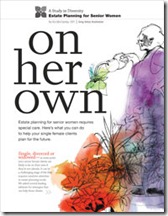 I learned last week that almost half of the people over age 65 in America are single.
I learned last week that almost half of the people over age 65 in America are single.
Simply put, wow!
While getting older has its benefits (if you don’t think so, you need to read this column more often), traveling the journey without a partner can be challenging or at least require some careful planning.
Being single these days comes in all shapes and sizes—never-married, separated, divorced or widowed— and with varied living arrangements—living alone or with a partner, friends, children, grandchildren or relatives.
Here are a few interesting facts about single seniors.
The number of single seniors living alone is on the rise, up 17 percent since 1970.
Almost one-third of all seniors age 65 and older are widowed.
The median age of widowhood is 58 years.
Certainly marriage does not guarantee any of us an easier ride as we age, but a marital partner may afford us another income, another option for health insurance or even a built-in caregiver.
A spouse may be the yin to our yang; if we are unwilling to plan for our future, they make take on the responsibility.
While it’s a good idea for both men and women to prepare for their future, women face greater risk if they don’t.
A 2011 MetLife study— “Women, Retirement, and the Extra-Long Life”—says that because women live longer they experience a number of unique risks in retirement, including aging single, lower retirement incomes, greater healthcare costs and caregiving responsibilities.
The study goes on to say that women have not planned adequately for their future.
Women have higher lifetime healthcare expenditures, in part due to their longer life expectancy (8 percent longer than men on average). Women are also less likely to be insured or adequately insured.
Women are more likely to be caregivers, with physical, emotional and financial consequences.
Women have significantly lower retirement income than men. The average retirement income from all sources for men age 65 and over in 2009 was $37,509; women’s income was 57 percent of that amount, or $21,519.
Whether male or female, being single means taking charge of our lives.
A big part of planning for our future is thinking about the unexpected. Through my work, I’ve developed seven questions that can help singles determine if they are prepared.
1. Who will help me if I am in a financial crisis?
2. Who will help me if I can no longer drive or take public transportation?
3. Who will write my checks and pay my bills if I can’t?
4. Who do I call if someone is abusing me—emotionally, financially or physically?
5. Who will check on me if I’ve fallen in my home and can’t get up?
6. Who knows my end-of-life wishes and will fulfill them for me?
7. Who will care for me if I can no longer care for myself?
The questions seem obvious, but the choices they represent are sometimes hard for single seniors to decide.
Did I choose the same person for each question?
Is my answer one of my children, a friend, a neighbor, a relative or a paid service provider?
Have I asked the people I have chosen to be there for me in crisis? Are they willing?
Can I get the help I need where I live today, or will I need to move to ensure support will be there for me when I need it?
Making these choices now or planning for them puts us in charge of our future and defines the support system we’d like. It’s one of the responsibilities of being a single senior.
More ...
Tags: Single senior women,life planning,MetLife study